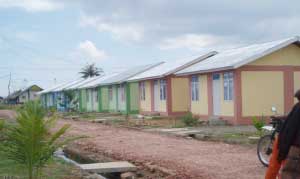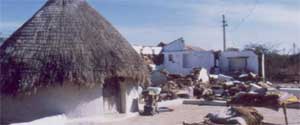Sustainable Post-Disaster Reconstruction
El Parker, Matthew Blackett, Marion MacLellan
Centre for Disaster Management and Hazards Research
School of Energy, Construction & Environment
Dan Watson
Humanitarian Engineering and Computing
The context
The Asian Tsunami in 2004 highlighted the complexities of the reconstruction phase. Media coverage often emphasizes the impact and relief phase, but the scale of devastation seen around the Indian posed a major long-term challenge for the sector. In normal circumstances housing and infrastructure develop organically over time using a range of mechanisms and technologies. After a disaster the pressure to provide permanent shelter for large numbers of people in a short period of time has historically led to some poor projects being implemented.
Often a result of an influx of relief agencies with limited local knowledge, experience and skills in reconstruction, overwhelmed government agencies, a desire to relocate communities, strict government and donor building requirements and limited engagement with beneficiaries.
The need
What we think we know about the sustainability of post disaster reconstruction is based almost entirely on end of project reports published as construction is completed. Rarely do agencies return to communities to ascertain whether or not the housing, service, infrastructure and other assets are providing effectively supporting.

Post Tsunami Aceh, Donor driven “house kits” often fail to meet the long-term needs of local people (picture courtesy of Arup International).
The Building and Social Housing Foundation (BSHF), who award the annual World Habitat Awards, annually review a host of housing projects implemented in both the development and post disaster phase. BSHF realized that they had an excellent opportunity to identify a recipe for success in post disaster housing reconstruction.
Staff in CDMHR partnered with the Building and Social Housing Foundation in a project that revisited a number of reconstruction projects implemented over the last 35 years to define key factors that influence their long term success and sustainability.
The solution
Working with the Building and Social Housing Foundation and NGO agency teams in-country who had originally implemented the reconstruction projects, we were able to collect primary data by interview and focus group from beneficiaries, those employed in the construction sector and government agencies. Eleven case studies were generated from across the globe including Guatemala, Sri Lanka, and Indonesia. An international conference was hosted on campus in January 2014 where findings were presented and key challenges and indicators of success where identified. Each case study and a synthesis of the findings can be found in an edited book: Still Standing? Looking back at Reconstruction and Disaster Risk Reduction (published by Practical Action).
The impact
The research findings have already influenced strategy internationally – Dr El Parker was invited to speak at the UN-Habitat conference in Sri Lanka in March 2014; where donor agencies, national governments and INGOs came together to discuss approaches to post conflict reconstruction in northern Sri Lanka. The book is available to inform the sector and training courses will follow.

Damage caused to traditional Bhunga houses by the 2001 Gujarat Earthquake.
Still Standing? fills a major gap in the literature on housing reconstruction following disasters. The text examines five critical issues that surround the subject: user satisfaction, beneficiary targeting, replication by users, technical performance and livelihood generation. Thus it is essential reading for all involved in holistic recovery policy and practice, since it is crammed full of practical advice and rich case studies from international leaders in the field.
Ian Davis, Visiting Professor in Disaster Risk Management in Copenhagen, Kyoto, Lund and Oxford Brookes Universities
‘Which post-disaster reconstruction and recovery programmes have been truly successful? What are the critical elements that turn humanitarian shelter assistance into sustainable homes and communities? This much-needed publication provides the missing longer term analysis of what works and what does not, valuably informing the response to future disasters.
Graham Saunders, Head, Shelter and Settlements, International Federation of Red Cross and Red Crescent Societies




